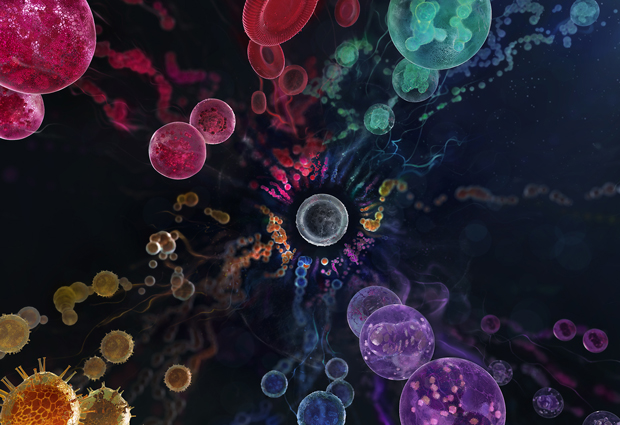
Blood stem cell differentiation is continuous
Study by EMBL and DKFZ researchers means origins of myeloid leukaemias may need rethinking

Every day, your body has to generate up to one trillion new blood cells, more if you suffer from an infection or severe bleeding. Ultimately, all of these cells derive from the adult haematopoietic stem cells (HSCs) in your bone marrow. For decades, the textbook view on this process has been that HSCs differentiate through a ‘tree’ of defined progenitor stages before finally becoming a specialised cell like a red blood cell or T cell.
Lars Steinmetz’s lab at EMBL, in collaboration with colleagues at the German Cancer Research Centre (DKFZ), have discovered that HSC differentiation is in fact a continuum: stem cells are locked on to the path to a specific cell type without passing through defined progenitor stages. Lars Velten, who carried out the research at EMBL, describes the work, which is featured on the cover of Nature Cell Biology this month.
What did you find?
We tried to find out how adult human HSCs differentiate into various mature cell types in the blood. Until now this question has mainly been studied by looking at whole populations of cells, which is what led to the ‘tree’ model in the textbooks. We set out to analyse this process at the level of single cells, using a technology we invented. This technology enables us to simultaneously study a cell’s function and its genome-wide gene expression. We were able to pinpoint exactly when HSCs commit to individual lineages. We found that this happens earlier than people thought, and that this differentiation is a gradual march towards mature cell types: we found no evidence that intermediate cell types exist.
Why does it matter?
Many cancers involve cells that derive from HSCs, so it is important to understand where the healthy versions of these cells originate. For example, myeloid leukaemias – which mainly affect adults – were thought to originate from one of these intermediate stages that we now show don’t exist. This begs the question of how these leukaemias really arise. To answer this, we’re planning to analyse myeloid leukaemias with the same single-cell methods we used in this study.
More broadly speaking, there’s been an assumption that other stem cells also differentiate through a ‘tree’-like process. Our work highlights the importance of thinking about development as a continuous process, and underscores the need for a single cell view on cellular decision-making processes.


